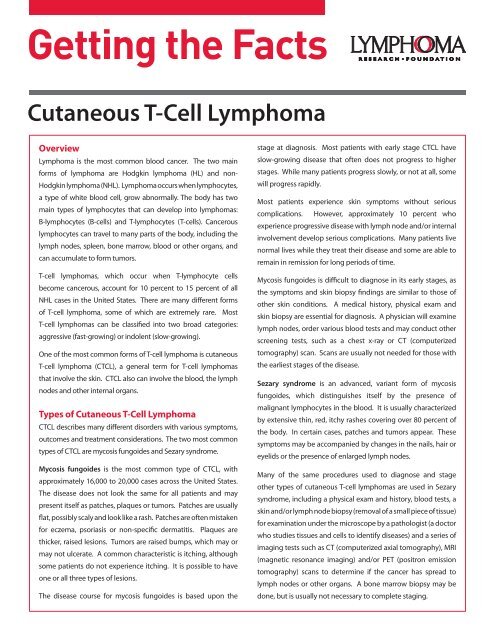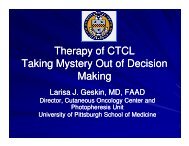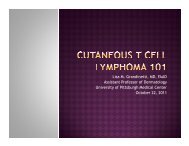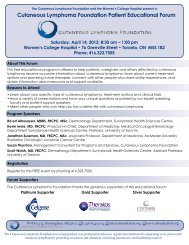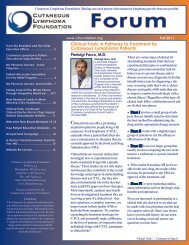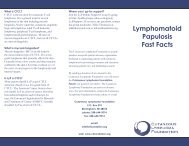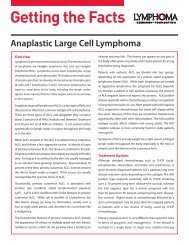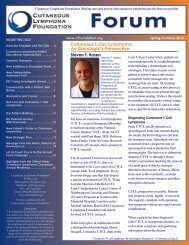Cutaneous T-cell Lymphoma (CTCL) or Mycosis Fungoides
Cutaneous T-cell Lymphoma (CTCL) or Mycosis Fungoides
Cutaneous T-cell Lymphoma (CTCL) or Mycosis Fungoides
Create successful ePaper yourself
Turn your PDF publications into a flip-book with our unique Google optimized e-Paper software.
<strong>Cutaneous</strong> T-Cell <strong>Lymphoma</strong><br />
Overview<br />
<strong>Lymphoma</strong> is the most common blood cancer. The two main<br />
f<strong>or</strong>ms of lymphoma are Hodgkin lymphoma (HL) and non-<br />
Hodgkin lymphoma (NHL). <strong>Lymphoma</strong> occurs when lymphocytes,<br />
a type of white blood <strong>cell</strong>, grow abn<strong>or</strong>mally. The body has two<br />
main types of lymphocytes that can develop into lymphomas:<br />
B-lymphocytes (B-<strong>cell</strong>s) and T-lymphocytes (T-<strong>cell</strong>s). Cancerous<br />
lymphocytes can travel to many parts of the body, including the<br />
lymph nodes, spleen, bone marrow, blood <strong>or</strong> other <strong>or</strong>gans, and<br />
can accumulate to f<strong>or</strong>m tum<strong>or</strong>s.<br />
T-<strong>cell</strong> lymphomas, which occur when T-lymphocyte <strong>cell</strong>s<br />
become cancerous, account f<strong>or</strong> 10 percent to 15 percent of all<br />
NHL cases in the United States. There are many different f<strong>or</strong>ms<br />
of T-<strong>cell</strong> lymphoma, some of which are extremely rare. Most<br />
T-<strong>cell</strong> lymphomas can be classified into two broad categ<strong>or</strong>ies:<br />
aggressive (fast-growing) <strong>or</strong> indolent (slow-growing).<br />
One of the most common f<strong>or</strong>ms of T-<strong>cell</strong> lymphoma is cutaneous<br />
T-<strong>cell</strong> lymphoma (<strong>CTCL</strong>), a general term f<strong>or</strong> T-<strong>cell</strong> lymphomas<br />
that involve the skin. <strong>CTCL</strong> also can involve the blood, the lymph<br />
nodes and other internal <strong>or</strong>gans.<br />
Types of <strong>Cutaneous</strong> T-Cell <strong>Lymphoma</strong><br />
<strong>CTCL</strong> describes many different dis<strong>or</strong>ders with various symptoms,<br />
outcomes and treatment considerations. The two most common<br />
types of <strong>CTCL</strong> are mycosis fungoides and Sezary syndrome.<br />
<strong>Mycosis</strong> fungoides is the most common type of <strong>CTCL</strong>, with<br />
approximately 16,000 to 20,000 cases across the United States.<br />
The disease does not look the same f<strong>or</strong> all patients and may<br />
present itself as patches, plaques <strong>or</strong> tum<strong>or</strong>s. Patches are usually<br />
flat, possibly scaly and look like a rash. Patches are often mistaken<br />
f<strong>or</strong> eczema, ps<strong>or</strong>iasis <strong>or</strong> non-specific dermatitis. Plaques are<br />
thicker, raised lesions. Tum<strong>or</strong>s are raised bumps, which may <strong>or</strong><br />
may not ulcerate. A common characteristic is itching, although<br />
some patients do not experience itching. It is possible to have<br />
one <strong>or</strong> all three types of lesions.<br />
The disease course f<strong>or</strong> mycosis fungoides is based upon the<br />
stage at diagnosis. Most patients with early stage <strong>CTCL</strong> have<br />
slow-growing disease that often does not progress to higher<br />
stages. While many patients progress slowly, <strong>or</strong> not at all, some<br />
will progress rapidly.<br />
Most patients experience skin symptoms without serious<br />
complications. However, approximately 10 percent who<br />
experience progressive disease with lymph node and/<strong>or</strong> internal<br />
involvement develop serious complications. Many patients live<br />
n<strong>or</strong>mal lives while they treat their disease and some are able to<br />
remain in remission f<strong>or</strong> long periods of time.<br />
<strong>Mycosis</strong> fungoides is difficult to diagnose in its early stages, as<br />
the symptoms and skin biopsy findings are similar to those of<br />
other skin conditions. A medical hist<strong>or</strong>y, physical exam and<br />
skin biopsy are essential f<strong>or</strong> diagnosis. A physician will examine<br />
lymph nodes, <strong>or</strong>der various blood tests and may conduct other<br />
screening tests, such as a chest x-ray <strong>or</strong> CT (computerized<br />
tomography) scan. Scans are usually not needed f<strong>or</strong> those with<br />
the earliest stages of the disease.<br />
Sezary syndrome is an advanced, variant f<strong>or</strong>m of mycosis<br />
fungoides, which distinguishes itself by the presence of<br />
malignant lymphocytes in the blood. It is usually characterized<br />
by extensive thin, red, itchy rashes covering over 80 percent of<br />
the body. In certain cases, patches and tum<strong>or</strong>s appear. These<br />
symptoms may be accompanied by changes in the nails, hair <strong>or</strong><br />
eyelids <strong>or</strong> the presence of enlarged lymph nodes.<br />
Many of the same procedures used to diagnose and stage<br />
other types of cutaneous T-<strong>cell</strong> lymphomas are used in Sezary<br />
syndrome, including a physical exam and hist<strong>or</strong>y, blood tests, a<br />
skin and/<strong>or</strong> lymph node biopsy (removal of a small piece of tissue)<br />
f<strong>or</strong> examination under the microscope by a pathologist (a doct<strong>or</strong><br />
who studies tissues and <strong>cell</strong>s to identify diseases) and a series of<br />
imaging tests such as CT (computerized axial tomography), MRI<br />
(magnetic resonance imaging) and/<strong>or</strong> PET (positron emission<br />
tomography) scans to determine if the cancer has spread to<br />
lymph nodes <strong>or</strong> other <strong>or</strong>gans. A bone marrow biopsy may be<br />
done, but is usually not necessary to complete staging.
Treatment Options<br />
Selecting a treatment f<strong>or</strong> a patient depends on the symptoms, the patient’s general health and<br />
National Headquarters<br />
115 Broadway, Suite 1301<br />
New Y<strong>or</strong>k, NY 10006<br />
(212) 349-2910<br />
(212) 349-2886 fax<br />
Helpline: (800) 500-9976<br />
Helpline@lymphoma.<strong>or</strong>g<br />
Website: lymphoma.<strong>or</strong>g<br />
Email: LRF@lymphoma.<strong>or</strong>g<br />
The <strong>Lymphoma</strong> Research Foundation<br />
offers the following patient education and<br />
supp<strong>or</strong>t programs:<br />
• <strong>Lymphoma</strong> Helpline<br />
• Clinical Trials Inf<strong>or</strong>mation Service<br />
• <strong>Lymphoma</strong> Supp<strong>or</strong>t Netw<strong>or</strong>k<br />
• Publications<br />
• Teleconferences<br />
• Webcasts & podcasts<br />
• In-person conferences<br />
Medical reviewer:<br />
Steven M. H<strong>or</strong>witz, MD<br />
Mem<strong>or</strong>ial Sloan-Kettering Cancer Center<br />
stage of disease. F<strong>or</strong> mycosis fungoides, treatment is either directed at the skin <strong>or</strong> the entire body<br />
(systemic). Because Sezary syndrome is chronic and systemic (affecting the entire body), it is<br />
usually not treated with skin-directed therapies alone. Treatments may be prescribed alone <strong>or</strong> in<br />
combination to achieve the best long-term benefit.<br />
Skin-Directed Therapies<br />
Systemic Therapies<br />
• Ultraviolet light (PUVA, UVB,<br />
• Denileukin diftitox (Ontak)<br />
narrow-band UVB)<br />
• Extrac<strong>or</strong>p<strong>or</strong>eal photopheresis<br />
• Topical steroids<br />
• Gemcitabine (Gemzar)<br />
• Topical chemotherapies (nitrogen mustard, • Interferon alfa<br />
carmustine)<br />
• Liposomal dox<strong>or</strong>ubicin (Doxil)<br />
• Topical retinoids (bexarotene gel)<br />
• Methotrexate (Trexall)<br />
• Local radiation<br />
• Oral retinoids (bexarotene capsules)<br />
• Total skin electron beam therapy<br />
• Romidepsin (Istodax)<br />
• V<strong>or</strong>inostat (Zolinza)<br />
Some second-line therapies, in addition to those listed above, f<strong>or</strong> relapsed (recurrence of the<br />
disease) <strong>or</strong> refract<strong>or</strong>y (disease that is resistant to treatment) patients include: b<strong>or</strong>tezomib (Velcade),<br />
chl<strong>or</strong>ambucil (Leukeran), cyclophosphamide (Cytoxan), etoposide (Toposar), pentostatin (Nipent),<br />
and temozolomide (Temodar).<br />
Treatments Under Investigation<br />
There are several treatments being tested in clinical trials f<strong>or</strong> <strong>CTCL</strong>.<br />
Developed in collab<strong>or</strong>ation with:<br />
clfoundation.<strong>or</strong>g<br />
• Allogeneic stem <strong>cell</strong> transplant<br />
• Autologous dendritic <strong>cell</strong> vaccine<br />
• B<strong>or</strong>tezomib (Velcade)<br />
• Enzastaurin<br />
• F<strong>or</strong>odesine (BCX-1777)<br />
• Lenalidomide (Revlimid)<br />
• Mogamulizumab (KW-0761)<br />
• Pralatrexate (Folotyn)<br />
• V<strong>or</strong>inostat (Zolinza)<br />
• Zanolimumab (HuMax-CD4)<br />
Supp<strong>or</strong>ted through grants from:<br />
Treatment options may change as new treatments are discovered and current treatments are<br />
improved. Theref<strong>or</strong>e, it is imp<strong>or</strong>tant that patients check with the <strong>Lymphoma</strong> Research Foundation<br />
<strong>or</strong> their physician f<strong>or</strong> any treatment updates that may have recently emerged.<br />
Participating in Clinical Trials<br />
Clinical trials are crucial in identifying effective drugs and determining optimal doses f<strong>or</strong><br />
lymphoma patients. Patients interested in participating in a clinical trial should talk to their<br />
physician. Contact the <strong>Lymphoma</strong> Research Foundation’s Helpline f<strong>or</strong> an individualized clinical<br />
trial search by calling (800) 500-9976 <strong>or</strong> emailing helpline@lymphoma.<strong>or</strong>g.<br />
©2011 <strong>Lymphoma</strong> Research Foundation<br />
Getting the Facts is published by the<br />
<strong>Lymphoma</strong> Research Foundation (LRF) f<strong>or</strong> the<br />
purpose of inf<strong>or</strong>ming and educating readers.<br />
Because each person’s body and response to<br />
treatment is different, no individual should<br />
self-diagnose <strong>or</strong> embark upon any course of<br />
medical treatment without first consulting<br />
with his <strong>or</strong> her physician. LRF is not<br />
responsible f<strong>or</strong> the medical care <strong>or</strong> treatment<br />
of any individual.<br />
Last Updated November 2010<br />
Reprinted October 2011<br />
Resources<br />
The <strong>Lymphoma</strong> Research Foundation (LRF) offers a range of resources addressing treatment<br />
options, research advances and coping with lymphoma. F<strong>or</strong> a m<strong>or</strong>e comprehensive source of<br />
NHL inf<strong>or</strong>mation, visit LRF’s website to view <strong>or</strong> <strong>or</strong>der the publication entitled Understanding<br />
Non-Hodgkin <strong>Lymphoma</strong>: A Guide f<strong>or</strong> Patients, Surviv<strong>or</strong>s and Loved Ones. LRF also provides many<br />
educational activities, from in-person meetings to teleconferences and webcasts. F<strong>or</strong> m<strong>or</strong>e<br />
inf<strong>or</strong>mation, visit lymphoma.<strong>or</strong>g, e-mail helpline@lymphoma.<strong>or</strong>g <strong>or</strong> call (800) 500-9976.


